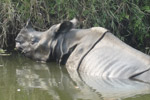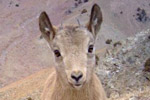Four donors from around the world have pledged $80 million to cat conservation group, Panthera. The money will fund projects working to preserve tigers, lions, jaguars, cheetahs, leopards, snow leopards, and cougars over ten years.
“Today marks a turning point for global cat conservation,” said Panthera Founder and Chairman of the Board, Thomas Kaplan, who added that the support of Abu Dhubai’s Crown Prince, Sheikh Mohamed bin Zayed Al Nahyan, “is a game changer, opening a path for us to create what has become an unprecedented alliance of philanthropists from Arabia, China, India and America, now united in a common cause.”
In addition to support from Al Nahyan, the other funders include Panthera’s founders, Thomas Kaplan and Daphne Recanati Kaplan; Jho Low, the CEO of Jynwel Capital; and Hemendra Kothari, Chairman DSP Blackrock India and the Wildlife Conservation Trust.
All around the world big cats are vanishing. African lions (Panthera leo) have fallen from around 100,000 to somewhere between 15,000-35,000 individuals in just 50 years, while a recent survey found that West Africa’s lions—a distinct subspecies—are likely down to just 250 individuals and on the edge of extinction.

A lion in Kruger National Park in South Africa. Lion populations have plummeted in recent years and the West African lion is on the verge of extinction. Photo by: Rhett A. Butler.
Meanwhile, scientists believe that just 3,200 tigers (Panthera tigris) survive in the wild today, less than the number of tigers found in captivity in the U.S. Also, snow leopards are down to 3,500-7,000 individuals, and cheetahs to about 10,000 adults.
Most of the world’s big cats face similar threats: deforestation, habitat loss, prey decline, poaching for wildlife parts, trophy hunting, and human-wildlife conflict.
But big cats are also some of the biggest recipients of conservation funds. For example, a global Tiger Summit in 2010 raised $300 million for tigers. The summit was also notable for being the first high-level international meeting aimed at saving a single species.
Although founded in just 2006, Panthera has quickly become among the world’s leading conservation group working with wild cats.
IUCN Red Listing for the World’s Big Cats
- Cheetah: Vulnerable
- Cougar: Least Concern
- Jaguar: Near Threatened
- Leopard: Near Threatened
- Lion: Vulnerable
- Snow Leopard: Endangered
- Tiger: Endangered
Related articles
Kala: the face of tigers in peril

(03/27/2014) In 1864, Walter Campbell was an officer in the British Army, stationed in India when he penned these words in his journal: “Never attack a tiger on foot—if you can help it. There are cases in which you must do so. Then face him like a Briton, and kill him if you can; for if you fail to kill him, he will certainly kill you.” In a stroke of good fortune for the tiger, perceptions in India have changed drastically since Campbell’s time. Tiger hunting is now banned and conservationists are usually able to rescue the big cats if they become stranded while navigating increasingly human-occupied areas. But is this enough to save the tiger?
Proposed rail and road projects could devastate Nepal’s tigers and rhinos

(02/06/2014) Chitwan National Park is a conservation success story. Since its establishment in 1973 the park’s populations of both Bengal tigers (Panthera tigris tigris) and one-horned rhinos (Rhinoceros unicornis) have quintupled, a success achieved during a time when both species have been under siege globally by poachers. A UNESCO World Heritage site, the park is also a vital economic resource for locals: last year the park admitted over 150,000 tourists who brought in nearly $2 million in entry fees alone. But all this is imperiled by government plans for a new railway that would cut the park in half and a slew of new roads, according to a group of international conservationists known as the Alliance of Leading Environmental Researchers and Thinkers (ALERT).
Predator appreciation: how saving lions, tigers, and polar bears could rescue ourselves

(01/29/2014) In the new book, In Predatory Light: Lions and Tigers and Polar Bears, authors Elizabeth Marshall Thomas, Sy Montgomery, and John Houston, and photographers Cyril Christo and Marie Wilkinson share with us an impassioned and detailed appeal to appreciate three of the world’s biggest predators: lions, tigers, and polar bears. Through lengthy discussions, combining themes from scientific conservation to local community folklore, In Predatory Light takes us step by step deeper into the wild world of these awe-inspiring carnivores and their varied plight as they facedown extinction.
Snow leopards and other mammals caught on camera trap in Uzbekistan (photos)

(01/16/2014) Scientists knew that snow leopards (Panthera uncia) still survived in the Central Asian country of Uzbekistan, but late last year they captured the first ever photos. Camera traps in the Gissar Nature Reserve took photos of the big cats, along with bear, lynx, ibex, wild boar, and other mammals. The camera trap program was led by biologists Bakhtiyor Aromov and Yelizaveta Protas working with Panthera, WWF’s Central Asia Program, and Uzbekistan’s Biocontrol Agency.
German government gives tigers $27 million
(01/14/2014) At a summit in 2010, the world’s 13 tiger range states pledged to double the number of tigers (Panthera tigris) in the wild by 2020. Today, non-tiger state Germany announced its assistance toward that end. Through its KfW Development Bank, the German government has pledged around $27 million (20 million Euro) to a new program run by the International Union for Conservation of Nature.
Lions face extinction in West Africa: less than 250 survive

(01/08/2014) The lions of West Africa, which may represent a distinct subspecies, are on the precipice of extinction. A sober new study in PLOS ONE reports that less than 250 mature lions survive in the region. Scientists have long known that West Africa’s lions were in trouble, but no one expected the situation to be as dire as it was. In fact, in 2012 scientists estimated the population at over 500. But looking at 21 parks, scientists were shocked to find lions persisted in just four with only one population containing more than 50 individuals.
86 percent of big animals in the Sahara Desert are extinct or endangered

(12/03/2013) Bigger than all of Brazil, among the harshest ecosystems on Earth, and largely undeveloped, one would expect that the Sahara desert would be a haven for desert wildlife. One would anticipate that big African animals—which are facing poaching and habitat loss in other parts of the world—would thrive in this vast wilderness. But a new landmark study in Diversity and Distributions finds that the megafauna of the Sahara desert are on the verge of total collapse.